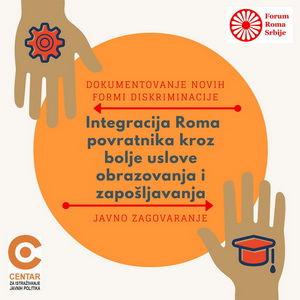 Author: Tanja Jakobi (Social Inclusion Blog)
Author: Tanja Jakobi (Social Inclusion Blog)
In November of last year the Public Policy Research Centre and the Roma Forum of Serbia started to seek answers to the question of whether there are new, as yet unexplored options for the employment of returnees of Roma origin based on the Readmission Agreement.
During project implementation we recorded sixteen human stories of returnees and their families arriving to Serbia after a year-long, and often multiple-decades-long absence from the country, we talked to representatives of institutions and the non-government sector in the field, in Novi Sad and Subotica, and a large number of representatives of national institutions and organizations, including mixed chambers of commerce and foreign investors doing business in Serbia.
Of the 16 survey respondents, 9 did not attend school, have incomplete primary or completed primary school, while one respondent stated they have 10 grades of primary school. Although their education level places them in the category of difficult to employ persons, some of them have skills that could, it would seem, open doors for them in a regular job: one is a flower-shop salesperson, the other a tinsmith, another can play an instrument, yet another worked on simple construction, while another two have licences to drive a dredge or hold a driver’s licence. Six respondents have secondary vocational education (construction, mechanical engineering, wood processing, transport, catering and trade schools), while one has higher education (administration and banking), with four of them acquiring their diplomas in EU countries. Six of the ten respondents (whether with primary or secondary school) worked abroad, either within social empowerment measures or holding regular jobs. Only one of them found work in Serbia, another is working as a musician, while ten of them are receiving social assistance, child allowance, or help from their parents, whereas the remaining ones are working illegally or in occasional informal jobs.
What do these results tell us? Is this low level of employability the result of a randomized sample or does it tell us something more?
Since 2009, when the Strategy of Reintegration of Returnees based on the Readmission Agreement was adopted, to date, as a state we have been equally unsuccessfully guessing how many returnees arrive to, or leave Serbia each year, we have no solid quantitative data on the number of returnees on the records of the National Employment Service (NES) and the skills and know-how they have. (…) If we ask ourselves what could be done to improve the educational process and thus affect the higher changes of employment of child returnees, we will also face a number of unknowns: what schools are the children of returnees coming from? What curricula was used for teaching there? How many of them manage to become integrated into the educational system and complete primary school? What secondary schools did these children attend and are there complementary schools in Serbia where they could continue their education (…)? What foreign languages do these children and their parents speak and how well? (…)
In this almost full quantitative darkness, surveys, including ours, send out a, it would seem, unified signal. Although they are significantly more oriented towards employment than receiving social assistance and are ready for various forms of support in employment, and particularly self-employment, Roma returnees frequently remain unemployed and forced to turn to the grey economy. Although they recognize employment as the best way to break the circle of poverty and increase their changes of employment, and tend to involve their children in the educational system, due to the lack of psychological support and adequate additional instruction fund their children sometimes “fall off” of the peer train and fail to obtain a diploma that would/could lead to employment.
How do we find a “link” that would make it possible for the potential of Roma returnees, created during their stay in the EU, to be more efficiently utilized in Serbia?
(…)
The text in its entirety can be found on the Social Inclusion Blog.
 Government of the Republic of Serbia
Government of the Republic of Serbia















 pdf [271 KB]
pdf [271 KB]
Leave a Comment